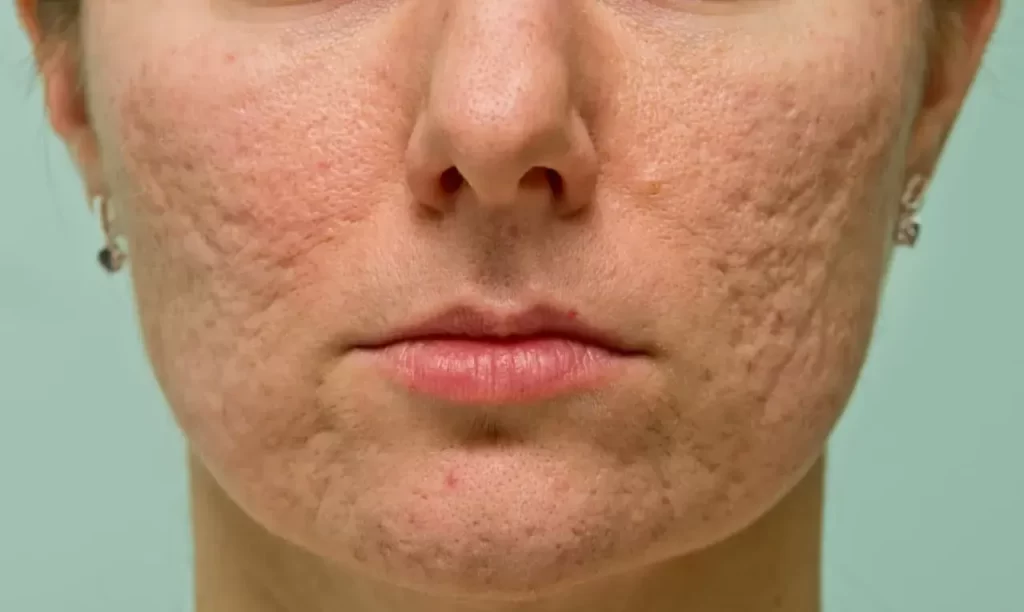
The most important thing in preventing scars caused by acne is to prevent outbreaks. It is best to consult a dermatologist or licensed esthetician so that they can treat the current blemishes before they get worse and become larger resulting in scarring.
Picking at or squeezing pimples should be avoided as this increases chances of getting more pimples and leaves behind permanent marks, it may also be helpful if one was to see a doctor who specializes with skin problems; such as dermatologists or estheticians about over-the-counter products which help reduce scarring risks like creams containing retinoids which are vitamin A derivatives; these work by increasing cell turnover rate thus reducing clogging up pores leading bacteria entry causing inflammation leading infection resulting into pustules etcetera.
Topical Medications Over-The-Counter (OTC)
Scars from acne can be permanent but their appearance can be lessened through treatment. The type of treatment you choose will depend on how deep and widespread your scars are as well as what kind of skin you have and what you want done.
If you notice new blemishes appearing it is better if they are treated early rather than waiting for them to heal fast by picking at them because this will make them heal slowly leaving bigger holes behind thus creating an ideal environment where more bacteria could thrive leading infections causing inflammations that result into cysts etcetera.
Dermatologists usually use laser resurfacing or chemical peels to reduce acne scars; ablative lasers remove thin layers of skin while non-ablative ones do not but both methods yield similar results over time. Trichloroacetic acid, Jessner’s solution, salicylic acid and glycolic acid are some examples of chemicals used during peeling procedures aimed at removing top dead layer containing many unwanted dark pigments responsible for giving rise to dull complexion.
Resurfacing Laser
Laser skin resurfacing can transform the texture and tone of your skin while diminishing discoloration and acne scars.Dermatologists use ablative lasers which remove thin layers of skin or non-ablative ones that do not; they also employ fractionated lasers which treat only a fraction of the area at one time.
These treatments are performed under local anesthesia in the office of a dermatologist and may not completely eliminate all imperfections caused by previous inflammations but will definitely make them less visible than before.
By heating up lower part called dermis, laser therapy induces formation collagen fibers thus helping flatten out specific types such as those left behind after deep cystic pimple has healed besides reducing other types like keloids or wrinkles found elsewhere on body surface.
Peel Chemical
Chemical peels disrupt normal cell development through controlled wounding with chemicals in order to stimulate regeneration leading eventually to improved appearance both textural and color wise1,2 . One should therefore see a board certified plastic surgeon or dermatologist who specializes in this type of treatment for advice best suited according to ones’ needs depth expected results etcetera; it is important also that they take into consideration individual patient characteristics like their skin type, goals desired level treatment etcetera in order to obtain optimal outcomes from these procedures.
Light chemical peels are suitable for treating mild scarring and improving overall skin tone. A light peel involves cleansing your face thoroughly then applying an acid peeling agent that causes slight burning or stinging when it touches – but only lasts momentary!
Medium-depth peels can be used on moderate cases of scarring caused by acne vulgaris. The doctor will apply glycolic acid (or another appropriate chemical) using cotton-tipped applicators directly onto the face during treatment sessions; deep peels involve stronger solutions penetrating deeper layers beneath epidermis so as to reach damaged areas where scar tissue forms.
Subcision
Various methods exist for treating acne scars. For example, subcutaneous injections of soft tissue fillers such as Juvederm, Restylane and Sculptra can be used to fill in indented scars while stimulating collagen production which helps reduce the appearance of scarring.
The procedure involves using a needle that is inserted beneath the skin’s surface to manually cut through any fibrous threads connecting an elevated or atrophic scar to its underlying tissue. The treatment area is first numbed with anesthesia before Dr. Green uses either an 18 or 20 gauge hypodermic needle to perform this technique which disrupts scars from forming by releasing them from their attachments below skin level where they are anchored down tightly against normal surrounding structures.
Subcision can be a good treatment for shallow boxcar scars that roll and fold but not deep icepick scars or deeper boxcar scars; subcision may need to be combined with other treatments such as dermal fillers and laser resurfacing to create the best acne scar treatment plan for an individual.
Cryosurgery
Cryosurgery is when you freeze the scar tissue so it dies and peels away, making it great for hypertrophic and keloid scars.
There are also treatments for rolling and boxcar scars, which have “M” shaped edges because they’re rolling or undulating due to dermal tethering (rolling) or well-established vertical edges that look like an indentation on the skin surface (“U” shaped).
To treat different lesions of sizes, cryosurgery uses a device with various nozzles. Physicians can decide how long liquid nitrogen should be applied directly onto each lesion by using a timed spot-freeze technique which increases treatment efficacy. Doctors don’t usually have to do anything else about local swelling or blistering since they tend to go away in 10-14 days.



More Stories
The Role of Microneedling in Acne Prevention
How to Manage Acne in Different Climates
The Link Between Diet and Acne – Debunking Myths